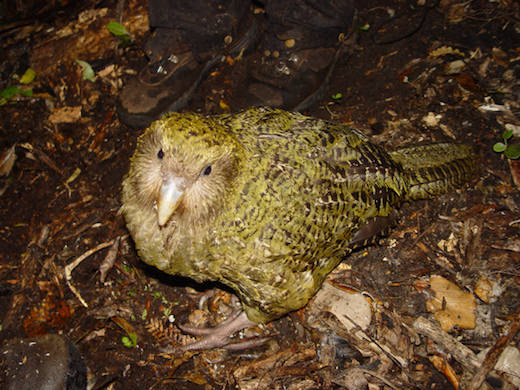Kakapo

Critically endangered
Kakapos are native to New Zealand and are also known as ‘owl parrots’ because they have unmistakable faces that look freakishly similar to owls. These parrots not only have the face of an owl, they also have a posture very similar to a penguin, and walk or waddle like a duck. What’s especially interesting about these parrots is the fact that they don’t actually fly and instead walk everywhere. They’re the heaviest of all of the parrot species, weighing in at roughly 6 kg and achieving an average size of 25 inches. Its plumage is a moss green and brown colour, which helps it blend into its surroundings. It is actually the only flightless breed of parrot in the world, but even so, it still is able to get around very well, all thanks to the way its legs are designed. Its legs are extremely strong which help it to hike and climb steep incline and almost jog around on flat surfaces. They’re able to climb very tall trees and can actually use their wings like a parachute to help get them safely back down to the forest floors. They’re also nocturnal and only come out at night, roosting on the ground or in trees during the daytime. They’re known to be friendly animals, even wild ones and are often kept as pets.
Population Distribution
Commonly found throughout New Zealand, typically in thick woods and forests, Kakapos began to decrease in numbers after the arrival of the Maori. By the 1930’s they disappeared for good from the North parts of the island, but did much better on the South Island thanks to the wetter weather, which kept people and predators at bay. Around 200 or so birds were discovered on Stewart Island back in the late 70’s and around a decade or so later, they were transferred to an island known as Codfish Island, just off of the coast from Stewart Island to areas that are free of predators such as big cats. As of 2012 there were only around 125 of these birds remaining, all of which are monitored and fitted with radio transmitters to help keep them safe. It is believed however, that on other islands in the area, there are still more Kakapos remaining in the wild.
Threats
Perhaps most shockingly of all is the fact that human beings aren’t believed to be directly responsible for the declining numbers of Kakapos, and in fact human beings have gone out of their way to help to protect them and increase their numbers to prevent them from going extinct. The biggest threats to these parrots were predatory animals such as large cats, stoats, and rats which would eat the chicks and eggs. As the parrots cannot fly, they’re particularly at risk from predators with a keen sense of smell. They’re also notoriously difficult to breed as they suffer from low fertility.